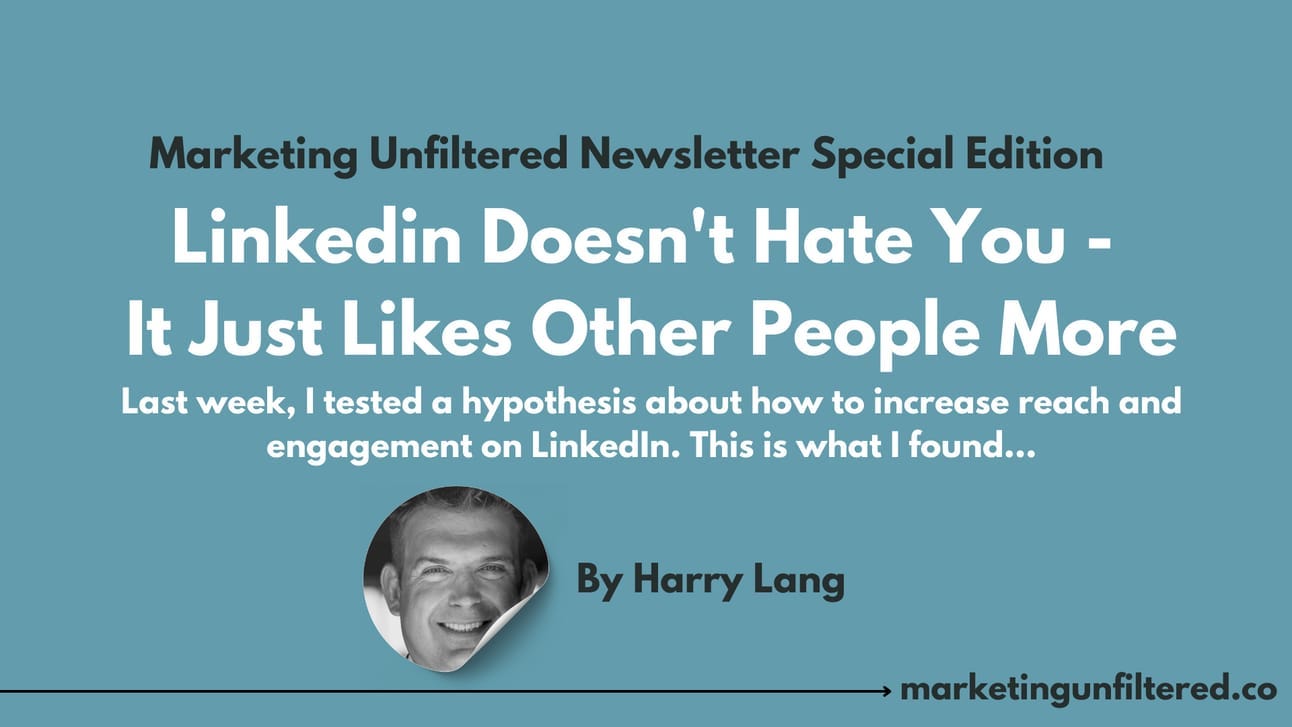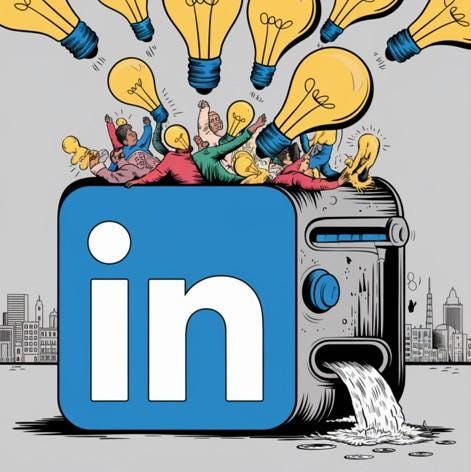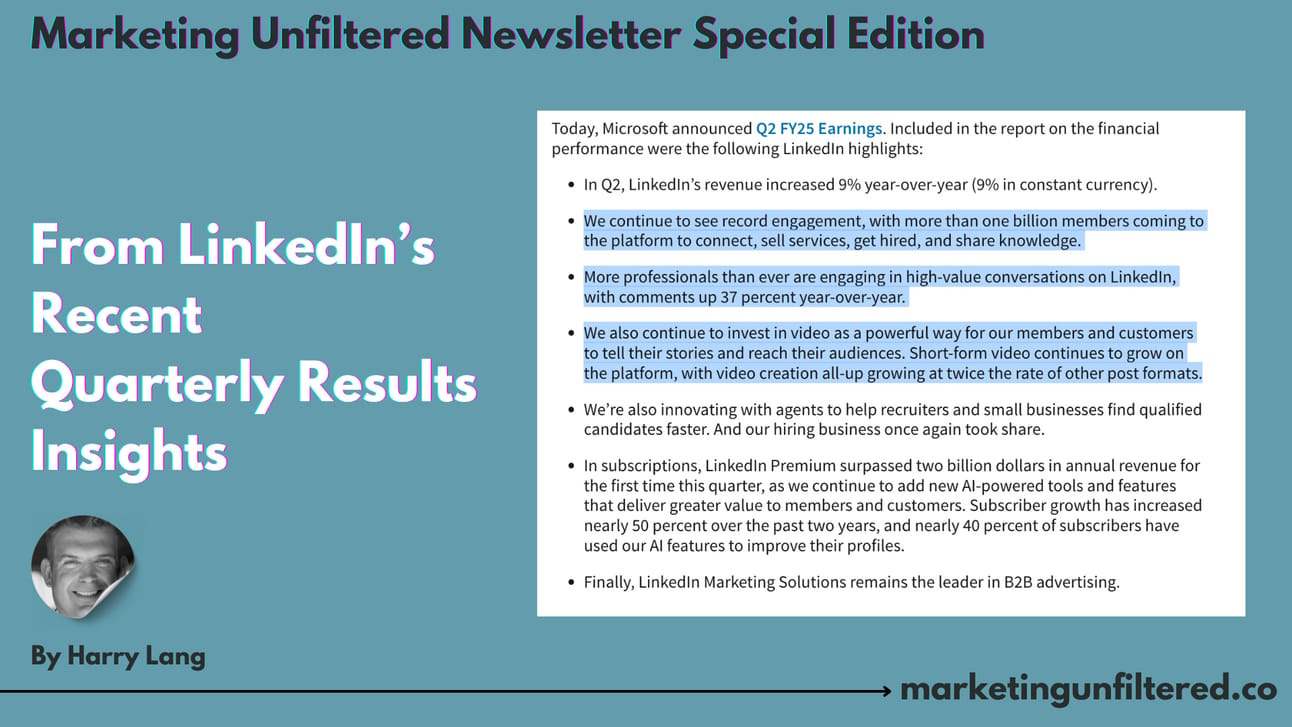Linkedin Doesn't Hate You - It Just Likes Other People More
Marketing Unfiltered #17 - Are We On A Course To Break Up With LinkedIn?
Happy Monday 👀, we land in your inbox with a surprise drop from Harry with Marketing Unfiltered newsletter #17.
If you missed Friday’s love letter to Digital Marketing from John, you can read it here.

LinkedIn Doesn't Hate You - It Just Likes Other People More
Last week, I tested a hypothesis about how to increase reach and engagement on LinkedIn. This is what I found…
Impressions through the floor, reach throttling, smug bizfluencers getting huge numbers while everyone else is fighting it out for scraps and a mystical algorithm that changes its mind with the regularity that most people change their pants. Such has been the collective experience for everyone on LinkedIn in recent years, myself included.
'If you engage and comment with other people's posts before and after you post yourself, does LinkedIn give you a reach boost?'

That was this insight from Aware’s ‘State of LinkedIn’ report last week that prompted me to explore what was going on with the ‘business’ social network and whether being a more frequent commenter would boost the reach of my own posts.
I publish regular, original marketing content on there - I enjoy the writing, and the majority of my consultancy clients have been inbound from the platform, which means I have a vested interest in building greater reach, engagement and followers. So what happened when I put this theory to the test?
The Experiment
I wrote a post about the findings in Aware’s report with a focus on LinkedIn rewarding those who comment regularly. I posted it at 7am on the Thursday morning, having commented on ten other posts before and following up with ten more after. The comments weren't generic space fillers, either - they had to be credible, otherwise I'd just become 'one of them'.
It started... poorly…
Minimum impressions, some comments, mostly prompted by the premise in the post. It was clear that because I'd suggested that 'comments = reach', it had garnered loads of comments by return, many of them joking about leaning into the theory. I'd accidentally become an engagement farmer!
Three hours after posting, and despite significant (30+) engagements, LinkedIn’s algo had throttled the post to just over 600 impressions.
Four hours in, I started to wonder what would happen if I somehow got more comments than impressions...
After five hours, Engagement (Likes & Comments) had been solid (over 100), but Impressions were still diabolical (just over 3k), which means LI has throttled post reach.
Finally, ten hours after the post went live, something interesting started to happen. Despite the impression throttling, the comments had spread the post globally and generated organic engagement of their own. Impressions shot up past 10k.
Two days later, it was still generating reach and engagement, with over 30k+ impressions, 266 Likes and 218 comments.
Sharing Is Caring
» OR copy and paste this URL into your favourite slack, teams or chat group https://marketingunfiltered.co/p/linkedin-love
Or share on WhatsApp
The Findings (& Theories)
Did the pre-loading and after post comments boost reach? No, quite the opposite. But then again, I only did it as a one off around this post, and a couple of people have suggested that LinkedIn needs to view you as a regular contributor before it’ll reward your behaviour.
I reckon that if commenting = reach + engagement, then it needs to be a constant effort, rather than a one off. So engagement farming becomes much like real farming, in that if you want to grow anything, you have to work bloody hard.
Did the post gain significant reach? Yes - but only because it attracted loads of comments, and they generated organic reach. This was, at least in part, because I'd claimed in the post that commenting = reach. I skewed the test by selling the very premise I was testing, which turned out to be false, and at the same time realised that there is some merit in ‘LinkedIn Socialism’.
If you want to game the system, I THINK (and there's a big health warning on that thinking) that you need to be consistent in both how you proactively post and reactively engage with the platform. Think of it as a child collecting points for good behaviour, except you don’t get a chart on the wall – your points are invisible and held on a server somewhere in Dublin. So you just need to trust the process, continually enact good behaviours and somehow your magical points will benefit you in the future.
Additionally, there’s a ‘comment quality’ question at stake, as iterated by Steffan Konrath, CEO of evAI:-
“When I developed comment analysis, the focus was not on algorithmic metrics but substantial contributions. While most LinkedIn users seem to overvalue the social reactions side, I learned that comments are more about the hard facts and how you can engage a community”.

Reported Growth - Record engagement numbers, comments up 37% YoY
Think like a LinkedIn RevOps professional - what can you do to benefit the ecosystem? If you become a positive contributor to both proactive and reactive activity, the platform will smile on you warmly.
No matter what you want to achieve, remember YOU ARE THE PRODUCT and LinkedIn will prioritise its own ability to make more money faster over anything as silly as your personal needs. Entrepreneur Fintan Costello flagged this as one of the reasons organic reach might be harder to achieve on LinkedIn than a few years ago:-
“Every social media platform goes through this at some point. Start throttling organic reach to boost ad sales”.
You also need to remember that LinkedIn is designed to be a growth beast, becoming ever busier with content fighting for an increasingly apathetic and myopic set of eyeballs. As marketing consultant Simon Hawtin commented:-
“Supply of posts is increasing and scrolling is probably not keeping pace, thus less discoverability”.
What’s The Answer?
If I knew the actual answer, I'd be selling a six week, five grand online course called 'LinkedIn Secrets Of the Pharaohs' to recruiters and thirsty SaaS marketers whilst posting glib witticisms from my yacht. As it is, I don't - so I can't.
What I do have are some serving suggestions - the things I believe will help boost your LinkedIn reach and engagement over time:-
Pick a lane - be a subject matter expert so your audience (and more crucially the LI algo) knows what you're all about. That said, John Wright from StatsDrone says he gets random hits when he posts about recruitment. Recruiters are highly active users, and Premium payers to boot, so it’d be no surprise if LI gives their industry content more love. However, we’re diving out of the ‘quality engagement’ pool and into the ‘vanity metrics’ one here, so I’d advise caution…
Write or film original, interesting, topical and amusing content about your specialist subject and post it regularly - 3+ times per week at a time most suited to your audience/ Geo (8.37am GMT seems to work well for me, but weekday lunchtimes are also strong)
Comment authentically on stuff you find interesting and have a useful take on. Lean into this more pre and post sharing your own content. Avoid sycophantic crap like 'Hmm - insightful' or AI generated cobblers. It might not hurt your ranking points, but it annoys the kidneys out of me and pretty much everyone else. Try and be useful, interesting, or amusing – preferably all three.
I hate to say it, but on any open forum, division multiplies. Promote arguments in your posts and your comments section will populate faster than a Wetherspoons punch up at closing time
Hook that fish – marketing leader Eden Hensley gave this strong advice about the importance of capturing eyeballs quickly:-
“Spend 40% of your time on your content and 60% on your hook”.
Use mixed media - people are lazy, so they like video - which means LI likes video, too. Plus high quality design assets or video definitely beat reshared, IP-owned photos, but AI seems to do a pretty decent job of creating image assets to match the tone and content of posts. (Subscribe to the Marketing Unfiltered newsletter at MarketingUnfiltered.co to read the AI edition - a How to... guide on the best of these).
Be authentic. If AI is guilty of anything, it's of being generic in its creativity - pulling in a million data sources to create a soup of compromised mediocrity. In the future, original, honest, open, and pragmatic thinking will stand out on LinkedIn like a cold Pint in the Sahara
Remember, this is a game with over a Billion players around the world, some of whom are playing with a loaded deck and with a dealer who changes the rules on a whim. ‘Test & Learn’ is the best methodology to find what works for you, but don’t beat yourself up if you struggle. You’re very much not alone.
So there it is – a “failed experiment” that ended up working by accident, militarised ‘engagement farming’, LinkedIn Socialism and a bunch of theories to test out over the coming weeks and months. For most, LinkedIn is an occasional platform but for many of you, it’s the lifeblood of your organic sales funnel, so getting this stuff right really matters to your bottom line.
It would be nice if LinkedIn and its Microsoft overlords were a little less secret squirrel about how the algo actually works but then again, it suits their needs to keep everyone in the dark, scrabbling about as they search in vain for a non-existent light switch.
As growth director Liam Cole eloquently put it:-
“Quality content alone doesn’t guarantee reach anymore. The game is now about reciprocity at scale. Comment first, post second. Scratch backs, get scratched. It’s not new, it’s just algorithmically enforced now”.
Harry Lang runs Brand Architects, a strategic marketing and brand consultancy. He’s a CMO and author of the 5 Star rated marketing guidebook ‘Brands, Bandwagons & Bullshit’ (available on Amazon).
You can connect with Harry on LinkedIn or email him at Harry@BrandArchitects.co.uk to discuss CMO roles or consultancy projects.
Want More LinkedIn Intel?
If you would like to read more about LinkedIn’s algorithm and the simple way of understanding how it likely works I wrote a quick overview post here.
What are your recent experiences with LinkedIn? Will you be taking any of Harry’s recommendations? Let us know by hitting replying to this email or dropping us a line to Harry@BrandArchitects.co.uk
Have a great week.
Thanks,
Danny, Harry and Marketing Unfiltered Writers
PS. Remember if you’ve missed any of Harry’s previous newsletters you can enjoy ↓

